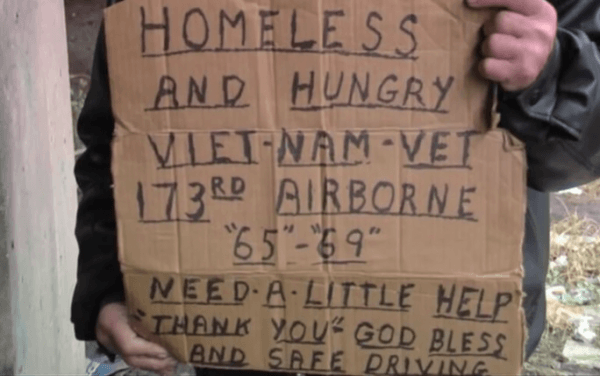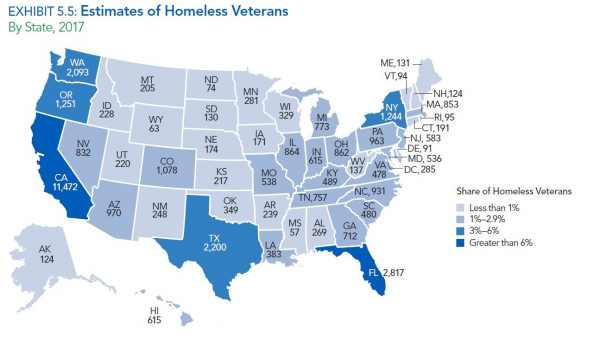Imagine the comfort of your home or office. It’s warm, dry, and with all the niceties you have come to understand as essential to a happy and productive life. Now, instead of your comfortable home or office, you are outside, but not walking to the nearest Starbucks for a latte or lunch with co-workers…you are living there. Your home is a cardboard box, or under an overpass, or in a public park, at least until you are told to move on by the authorities.
You have little shelter or none at all. When it rains you are wet; when it is cold you are freezing. When temperatures soar in the summer, you seek shade. You have no money and can’t remember the last time you had “three hots and a cot.” You and an estimated 47,000 brothers and sisters in arms are living in temporary shelters, in cars, or on the streets. Many American veterans face this sort of life every day.
We don’t want to hear about it, see it, or even say it…they are our homeless veterans, our nation’s silent shame.
It is a different kind of battlefield. It is fought under bridges, on streets and tucked away in dark alleyways. You are fighting against inadequate medical care, PTSD, substance abuse, no job opportunities, unpaid benefits, no place to live, and dysfunctional relationships, all in the aftermath of service to this country.

Lack of governmental oversight and follow-through with the Homeless Veterans Comprehensive Assistance Act of 2001 created a situation wherein inadequate access to healthcare, few job opportunities, untreated effects of post-traumatic stress, and substance abuse left veterans “hung out” and not adequately taken-care-of upon returning home after service.
Some eight years later, in 2009, the United States government accepted there was a problem with the rate of homelessness among veterans. Then-President Obama and the secretary of the Department of Veterans Affairs made a public pledge to “end veterans’ homelessness by the end of 2015.” Those deadlines passed, and there are still tens of thousands of homeless veterans on any given night across the country.
Just last December, Military Times reported that “the number of homeless veterans across America increased in 2017 for the first time in seven years, when government officials began their nationwide push to help impoverished former service members.”
Homeless by the Numbers
How many veterans are currently homeless in the United States? The answer to this question is done by conducting “point-in-time” counts. A point-in-time count done the last week of January (hence the term “on a single night in January”) is an “unduplicated count on a single night of the people in a community who are experiencing homelessness that includes both sheltered and unsheltered populations.”
Those communities receiving federal funds from the Department of Housing and Urban Development’s (HUD) McKinney-Vento Homeless Assistance Grants program must conduct an annual count of all sheltered people. Unsheltered populations are counted through the efforts of outreach workers and volunteers who canvas the streets, abandoned buildings, and encampments where homeless may live and congregate.
The US Department of Housing and Urban Development & Department of Veterans Affairs 2017 annual assessment to Congress (Veterans Supplement) identified on a single night in January:
- 40,056 veterans were experiencing homelessness in the US, just over nine percent of all homeless adults.
- 96 percent of homeless veterans are single males.
- Since 2016 the number of homeless veterans who were women increased by seven percent according to HUD. Female veterans are two to three times as likely to become homeless than any other demographic.
- Three in five homeless veterans (62 percent or 24,690 veterans) were staying in emergency shelters or transitional housing programs, while two in five (38 percent or 15,366 veterans) were found in places not suitable for human habitation.
- Almost all veterans were experiencing homelessness in households without children (98 percent or 39,101 veterans). About two percent (955) were veterans who were homeless as part of a family.
- Veterans are homeless an average of 6-10 years.
If a “picture paints a thousand words,” then the map from the annual report to Congress tells the story of our homeless veterans across the United States. The numbers are striking, with California having the highest number of homeless veterans: Almost three times the amount of any other state.

Homelessness is not what we promised those who served our country. We as a nation may not have promised to give our veterans a home, but we sure did promise to take care of them when what we put them through broke them.
What is the cause of so many veterans being on the street?
Many factors cause homelessness in the veteran population. Some are on the street by choice. As hard as that seems to understand, some homeless, and not just veterans, are living on the street by choice. That is a small percentage.
Many are victims of circumstances that just spiraled out of control. Drugs, economics, alcohol, and lack of employment all play a significant role in the homeless veteran population. Those broad categories are the easy part. They are obvious, but what is not apparent is why.
Some veterans were in trouble before joining or being drafted (think Vietnam). After leaving the service they were left with no job, no support, and depending on the time, they were placed at a disadvantage and looked down on by those who hadn’t served. Thankfully, the years of openly shunning the returning service members have, for the most part, ended.
Some veterans were wounded by what we asked them to do. The wounds we can see, the physical disabilities, the missing limbs, and the plainly visible scars so many veterans have are undeniable. And remember, every one of these now-wounded men and women was whole and healthy when they started their service.
But what about the veteran with the unseen wounds? On the surface, they look just like everyone else, but they are not. On the inside, the wounds and the scars are just as real.
How did we get to this point?
Combat changes everything. Today the service member is much more likely to deploy repeatedly. The type of conflict we have subjected our service members to for the last 28 years (yes, you read that correctly) means there is no end in sight, and that has a direct effect on our returning veterans.
Nature of the Beast
The battlefield is also different than the major wars of the past. The enemy seldom wears a uniform. IEDs, green on blue attacks, and the fact that no place is safe, not even inside US bases, all add to the invisible damage to our men and women that has become synonymous with mental wounds, PTSD, and the homeless veteran.
When you think of the homeless veteran on the street, what do you see?
Someone who is emotionally cut-off from others.
Someone who has lost interest in things.
Someone who is always on guard and hyper-vigilant.
Or maybe you see someone who is irritated or having angry outbursts.
They are having difficulty sleeping or concentrating.
Substance abuse, like alcohol or drug use.
When you start adding those up, it is understandable how that person ended up on the street.
When my husband returned from five years in the Middle East, I saw many of these same things. We worked through it together. What about all those veterans who don’t have a support system, a wife, a husband, a family waiting at home to lean on? They are left to fend for themselves, and this is where we can make a difference.
How Do We Fix It?
First and foremost we have to get our veterans off the street. Community after community is starting to move our homeless veterans off the street. Housing, education, job training, and medical and mental care all work together to tackle the problem. Homelessness in our veteran community is a monumental problem, and collectively we must recognize that. It is a responsibility, a debt, we owe to our veterans.
Through a combination of independent, local, state, and federal efforts, that “light at the end of the tunnel” is not a train. The situation is getting better. As of February 8, 2018, a total of three states and 58 communities have announced an end to veteran homelessness in their areas. They are proof it can be done.
As a nation, we must be willing and able to adequately care for homeless veterans who fought for this country. To do otherwise is not only a shame and a travesty of justice, but it is also the ultimate betrayal.
















